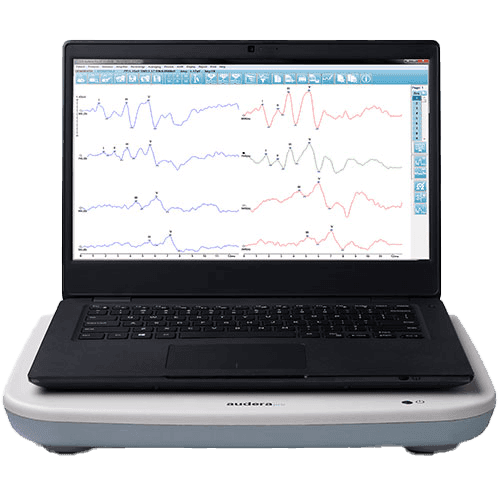
Grason-Stadler Audera Pro™
The GSI Audera Pro™ is the next generation of Grason-Stadler’s highly acclaimed clinical evoked potential and OAE systems. The Audera Pro offers a comprehensive battery of test types covering evoked potentials (EP) and otoacoustic emissions (OAEs). The Audera Pro comes with all of the great features of its predecessor, the Audera, and now offers a number of significant updates to support the needs of today’s audiology practices. Tests can be performed quickly and efficiently with customized test protocols. Results can be stored in its database management system, which allows for combining all test types into a single report.
Want to learn more about the Audera Pro?
Visit the Grason-Stadler website for a full breakdown of the features and benefits, along with a variety of educational materials.
Request a Quote
We understand that you have a choice when it comes to choosing your equipment and are dedicated to providing you with the highest quality instrumentation available. Contact us now for your free, no obligation quote and discover why we are the preferred Authorized Distributor and Service Provider to the world’s leading manufacturers. (Completing our online form does not sign you up for electronic advertising.)
NEW Clinical EP/OAE Device
Specifications
General
- Evoked Potentials: ECochG, ABR, MLR, LLR, SN10, P300, MMN, VEMP, ASSR
- Otoacoustic Emissions: DPOAE, TEOAE, SPOAE
- Warm Up Time: None at room/operating temperature
EP Stimulus Specifications
Stimulus Types: Click, CE-Chirp, Tones, CE-Chirp Octave Bands, Speech stimuli, User File
Click Duration: 100 uSec default (adjustable)
Tone Duration: Up to 500 ms (adjustable)
Tone Window Types: Rectangular, Hann, Blackman, Gaussian, Trapezoidal, Extended Cosine
Rate: 0.1 to 100 per second
Polarity: Rarefaction, Condensation, Alternating
MASKING
Type: White noise, specific level or relative to stimulus level
Frequency Response: Flat to 20 kHz (transducer limits determine roll off)
Maximum Output: 125 dB SPL
D/A: 16-bit
Level Accuracy: ±1 dB
Attenuation Range: 150 dB
Frequency Accuracy: ±1%
Total Harmonic Distortion:
- < 1% (DD45)
- < 3% (IP30)
- < 2% (B81)
- < .1% (SP90A)
EP Amplifier Specifications
Number of Channels: 2
Gain: 5000-200,000 (adjustable)
High Pass Filters: 0.1 Hz-300 Hz (adjustable) (-6 dB/Oct., -24dB/Oct. for 70 Hz)
Low Pass Filters: 30 Hz-5000 Hz (adjustable) (-6 dB/Oct., -24dB/Oct. for 500 Hz)
Sampling Rate: 200-40,000 Hz (adjustable)
A/D: 16-bit
Common Mode Rejection: > 110 dB @ 1 kHz, 50/60 Hz
Input Impedance: > 10 M Ohm
Noise Level: < 0.27 uV RMS
Artifact Rejections: Adjustable level (0-100%) and any region within the analysis time window
Line Frequency Filter: 50 or 60 Hz, -12 dB/Octave
Recording Window: -2.5 sec to 2.5 sec (maximum)
Data Points per Waveform: 1024
Digital Filters: Finite Impulse Response (FIR), band pass and notch
Electrode Impedance
- Measuring frequency: 1000 Hz
- Range: 1-25k Ohm
OAE Specifications
Sample Rate: 40k Hz
A/D: 16-bit
Frequency Accuracy: ±1% from selected
Frequency Analysis (FFT) Points
- DPOAE: 4096
- TEOAE: 1024
Frequency Resolution
- DPOAE: 9.8 Hz
- TEOAE: 39.1 Hz
Acquisition Time
- DPOAE: 102.24 ms
- TEOAE: 25.56 ms
STIMULI TEOAE:
- Stimulus: 75 uS click
- Presentation: Linear or non-linear train
- Level: 80 dB SPL (user defined 40-83 dB SPL)
- Stimulus Rate: 1-50/s (user defined)
- Stimulus Frequency Range: 250-5000 Hz
- Analysis Frequencies: 1000-4000 Hz
DPOAE:
- Stimulus: 2 Pure Tones (500-12000 Hz user defined start, end and F2/F1 ratio)
- Levels: 65/55 (user defined L1, L2, 0-80 dB SPL)
- Steps per Octave: 1-10 (user defined)
